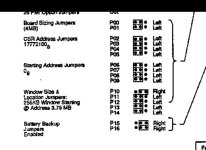nothing of note, i have one in my 11/83 and it's worked fine in the years i've had it
Good to know. Did you ever have that "machine's stuck in self-test at error 47, Memory CSR error" experience?
absolutely no clue what any of the jumpers do
How are yours set?
http://www.kpxx.ru/dec/PDP-11/Hardware/DCME-Q4E-F/ClearPoint DCME-Q4E-F-Front.JPG (and
http://www.kpxx.ru/dec/PDP-11/Hardware/DCME-Q4E-F/ClearPoint DCME-Q4E-F-switches.JPG; @Hunta states "the top four (размер памяти в Мб) determine the size of the memory") shows:
o All jumpers by the first two tabs are present
o Vertical row of three-position jumpers by third tab:
- Block of 2, both left
- Block of 4, first three left and fourth right
- Block of 4, all left
- Block of 5, first open with remainder right
o Pair of three-position jumpers by fourth tab:
- Block of 2, first right and second left
My attempts to translate the annotations yield (top to bottom):
"Размер памяти в Мб" = Memory size in MB
"Адрес CSR" = CSR Address
"Базовый адрес" = Base Address
I interpret the position of the annotations to indicate that the top two, rather than four, jumpers determine the memory size, presumably in MB with a minimum of one (jumpers both to right then?).
@malves21 posted this:

The QED1 example in the listing appears to have some jumper setting differences near both the third and fourth tabs. The CSR block is set left-left-left-right, consistent with the diagram above, but
http://www.kpxx.ru/dec/PDP-11/Hardware/DCME-Q4E-F/ClearPoint DCME-Q4E-F-Front.JPG has them set left-left-left-right. What CSR Address would the DEC diagnostics be expecting?
The bottom-most block near the third tab appears to be set as open and then right-right-right-right (the same as in
http://www.kpxx.ru/dec/PDP-11/Hardware/DCME-Q4E-F/ClearPoint DCME-Q4E-F-Front.JPG). Those settings suggest to me that perhaps the "window functionality" is disabled in both cases? Can anyone explain what's going on with this aspect of module configuration (Window Size & Location Jumpers)?
At least the pair of jumpers near the fourth tab are explained; seems that the eBay QED1 example module is configured with Battery Backup enabled. I see that
http://www.kpxx.ru/dec/PDP-11/Hardware/DCME-Q4E-F/ClearPoint DCME-Q4E-F-Front.JPG appears to be set right-left. Not sure why two jumpers would be employed here; ideas?
I see that 6 modules have now sold; 9 remaining. I wonder where their inventory is coming from?

